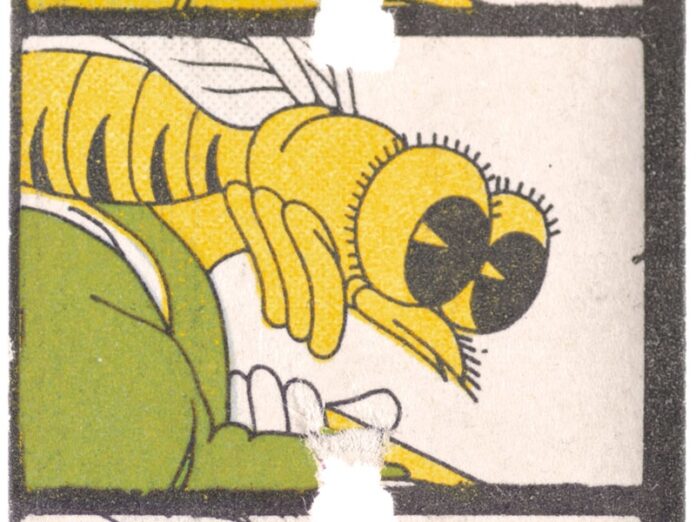Is it still a pathetic fallacy even if the weather is true but the drama is not? As I set out to begin my day with some major melodrama, there was heavy weather in the skies above Pordenone also. We shook off the rain in the Verdi foyer, while we prepared to dampen our faces with tears during the first of this year’s adaptations of East Lynne.
Ellen Wood’s famous sensation novel has far too much plot for most adaptations, even for this relative epic, Britain’s first six-reel film, directed in 1913 by Alexander Butler. I read the novel as (very entertaining) preparation for the festival and there are more twists and turns, disguises and disasters than I can summarise here. But in sum, don’t marry a man you don’t like, and don’t sleep with a man you don’t respect – timeless advice.
This British version of a novel that had already been adapted many times into plays and films, offers some of the best scenes in the book (though not Levison taking a dip in the village pond – my favourite) and rips through the action at speed. One could get lost, but although the setting was put back a couple of decades, this was a fairly faithful if not exhaustive attempt. the attention to detail in the often outlandish costuming was welcome. Blanche Forsythe made a strong Lady Isabel, very passionate, whom we see here in her stronger moments, not so much of her lonely, guilty crises, Fred Paul if anything underplays the noble Carlyle and Fred Morgan was a nicely leering villain as Levison – though unsure I would risk all for such an unappealing gent. Some gorgeous location shooting, down on the coast (we’re certainly not in the Welsh borders here) added to a fine melodramatic effort. And all accompanied with vigour by Phil Carli, curator of this strand, which is dedicated, touchingly, to the late David Mayer. This is a print from a private collection, restored by Bob Geoghegan of the Archive Film Agency and Christopher Bird, with the support of the BFI.
I saw a little of the first Italia Almirante Manzini film, the appropriately titled Notte di Tempesta (1917), accompanied beautifully by Meg Morley, but was a little overwhelmed by East Lynne, so retreated to do something more prosaic instead. Such lustrous hair, though, and this one did look pretty.
As the weather relaxed after lunch, we settled into one of the most anticipated programmes of the festival. The Japanese paper films, abbreviated, often adorable, all made between 1932 and 1938 were accompanied superbly by Yoko Reikano Kimura on the koto and Hikaru Tamaki on cello. This was an utterly beguiling presentation, packed with whimsical primary-coloured, often surreal animation, the occasional live-action nature clip and sometimes a little darker. The animations, filled with floating raccoon balloons, undersea adventures, dancing flowers and animal samurai, were to die for. Find out more here.
And to follow, more Koko in another Fleischer adventure, this time involving a little brother for our favourite monochrome clown, and a ginger kitten. Beware, though, cats really are having a bad time of it so far, not least in the Ukrainian children’s films strand, where yet again the kids were on the warpath when it comes to our feline pals. This one, Sam Sobi Robinzon (lazar Frenkel, 1929) about a young boy daydreaming of Robinson Crusoe when he should be at school, had a young leading man who, especially when in his cowboy gear, put me very much in mind of the Milky Bar Kid. It’s a slight thing and I wasn’t entirely sold but I did enjoy the music from Daan van den Hurk.
If you thought that tonight’s headline film, Fritz Lang’s 1921 epic of death in pursuit across centuries, continents and spectral realms, Der Müde Tod, was Sunday’s epic screening, well you would be wrong. Lang’s infinite spaces and enchanted voyages cannot compete with the late afternoon’s expedition into the outer reaches of the Chaplin universe. When Pordenone does a thing it does it right. So the Chaplin Connection strand is going to give us all a dose of Chaplinmania.
Stephen Horne was our man in the pit for two hours of arcane and archival treasures today, and he wrung the emotion out of a mixed programme that left us feeling wistful, but certainly sated. Some Chaplin-inspired comedies to begin, and then we lunged for the real deal. I loved the How to Make Movies (1982) doco shot in 1917 and 1918 in Chaplin’s brand new studio, showing, among many other things, the safe where the Tramp’s outfit was kept locked up. And then in a following segment, Chaplin Studio Visit with Roland Totheroh, shot in 1952 after the director was banished from the US, actress Kathryn Reed is shown the very same safe by Chaplin’s cinematographer. Shoes, hat and suit, just where they should be, in an otherwise poignantly empty studio, just gigantic cogs and iconic rooflines and such by which to remember past greatness.
Boundless amounts of behind-the-scenes footage must have been shot, with celebrities from Winston Churchill to Harry Lauder to Max Linder visiting the studio – Sir Albert and Lady Naylor-Leland were game to do camera tricks. And from there we went into the home movies, with Chaplin in full colour revisiting the London haunts of his youth in 1959, a formidable figure incongruous in a soot-stained terrace. Just to underscore the rag-to-riches trajectory, there he is visiting the Mountbattens in 1966. In 1922, Chaplin, Jackie Coogan and er, Lord and Lady Mountbatten had larked about in the garden at Pickfair to make a short crime film parody, Nice and Friendly, with an alarmingly high body count – as a wedding present to the couple, apparently. Well, I suppose they already had a good tea set. It’s very funny, and very odd.
Intertitles of the Day
“Give me treats or else!” Could be from one of the Japanese paper films, could have been me when I saw the vegana brioche in Bar Posta.
“The End. It’s enough” – Nice and Friendly. Well how can one argue?
- Still on three coffees a day. It’s fine, yeah?
- Step count: better than you’d think, but not good.
- Sine Nomine. Can you help identify an unidentified silent film?
- You can read more about the festival, and all of the films, on the Giornate website.
- I am on Letterboxd – watch me struggle to keep up with all these films.
- Silent London will always be free to all readers. If you enjoy checking in with the site, including reports from silent film festivals, features and reviews, please consider shouting me a coffee on my Ko-Fi page.



